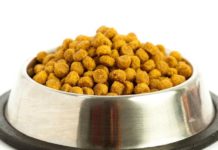
Whether you feed a homemade diet or a commercial product, the nutritional needs of your dog remain the same – healthy, balanced and nutritionally complete food in a palatable form. The argument that feeding kibble or manufactured food is a death sentence is extreme and unsubstantiated to a large degree as many of the manufactured foods that may have been nutritionally inadequate twenty or thirty years ago have improved their formulas to meet industry standards. Ingredients in dog food have improved in that time and although allegations of all sorts of horrible conclusions still circulate, the truth behind the ingredient label is no longer a mystery.
The Pet Food Institute (PFI) developed in 1958 out of a need to regulate pet food manufacturers. They developed a standard in which all manufacturers must adhere. They include:
- conspicuously identify the products as a dog or cat food
- select a brand name which is not misleading as to content or nutritional properties
- give a guaranteed chemical analysis that conforms to the state’s animal feed law
- give an ingredient listing in descending order of preponderance. Names of ingredients must be accepted as standard or common in use, and no one ingredient can be given undue emphasis (1)
On top of the standards put forth by PFI are the regulations monitored by the American Feed Control Officials (AAFCO) that state ‘a pet food label may not express or imply any claim that a product is complete, perfect, scientific, balanced, etc. food unless:
- it is nutritionally adequate for a normal animal in all of its life stages –growth, adult maintenance, and gestation/lactation
- the claim is modified by stating that it is complete and balanced for one or more specific life stages’
Dog food ingredients are confusing and many people decide on what to feed their dog by the recommendation of pet store employees or other shoppers instead of reading the label and understanding what they are feeding their pet.
Most often the first ingredient on a dog food label is either ‘ground corn’ or ‘meat and meat by-products’. Foods must be listed in ‘descending order of preponderance’ meaning by descending weights. Pet food manufacturers are not without their devious ways and by breaking down the foods into smaller groups such as ‘corn’ being labelled as ground corn, corn bran and corn flour splits the food into three smaller, or lighter, groups. On the flip side, by combining ‘meat and meat by-products’ together, it raises their placement on the ingredient label by increasing the overall weight.
What is Meat Meal?
Something to watch for is also the use of the term ‘meat meal’. Although it may not appeal to the human palate, meat meal is a highly nutritious combination of animal products that would otherwise be thrown out. These are the same bits that are classed as meat by-products and include brains, lungs, viscera, organs and connective tissue – all ingredients that have a substantial nutritional ‘punch’ to them. Meat meal is made by cooking, grinding and then dehydrating meat by-products and because it is dehydrated, it weighs light so is found low on the ingredient list. This is misleading to the ‘newbie’ dog food buyer and often foods containing meat meal are not as popular as foods that contain ‘meat by-products’ even though per pound, there is more nutritional value in ‘meal’ then in ‘by products’ as they remain 75% water.
Although dogs need carbohydrates for energy just like us, the quality of the grain is important to monitor. Grains are broken down into individual parts so they sit low on the ingredient label. Corn and wheat are the most common grains used yet both over time can cause skin and allergy problems in dogs. Brown rice, brewer’s rice and potatoes are fine sources of carbs and are more nutritionally dense then corn or wheat.
Additional fat is added to dog food listed plainly as ‘chicken fat’ or ‘beef fat’ etc. A general rule is to watch where it lies in the ingredient list. Fat weighs heavy because of its water content so if an ingredient list reads ‘brown rice, chicken meal, chicken fat’ the food is nutritionally dense with little filler added. The reverse would be a label that read ‘lamb, brewers rice, brown rice, poultry fat, rice flour, beet pulp, rice bran…’. Because meat is 75% water, it weighs heavy so it is first on the list and before the added fat, there are two heavy carbs or fillers. This food label is misleading and yet appealing in its variety of ingredients.
Preservatives are the last major concern in dog food ingredients. Without them, animal and vegetable fats would quickly turn rancid. Today, vitamin C (ascorbic acid) and E (includes seven different tocopherols) as well as antioxidants butylated hydroxyanisole (BHA) and butylated hydroxytoluene (BHT) are the first choice for quality preservatives and generally, the chemicals originally used to preserve the food are no longer a part of any dog food ingredient list. The exception being ‘ethoxyquin’ which, after 20 years of use and intensive research, continues to show no ill effects.
Buy foods listed as ‘natural’ or ‘organic’, read labels and pay attention to what your pet is eating. Commercial dog foods and dog food ingredients are not the ogre they are made out to be as long as some research and understanding goes into the purchasing decision. Remember, you get what you pay for and, like human food, when it comes to the health and happiness of your pet, the extra few dollars to buy a quality product is worth it in the end.
(1) Pet Food labelling requirements from the Pet Food Institute





